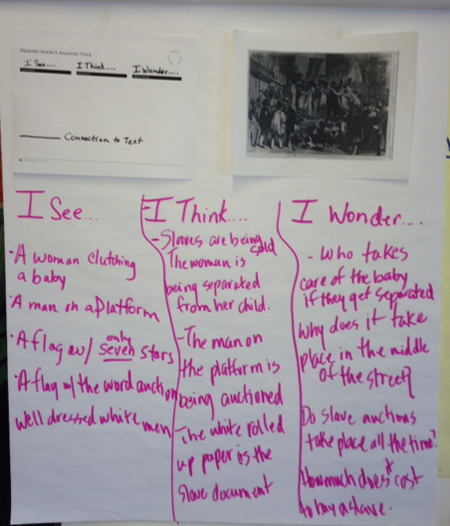Teaching Now: Using the Primary Source Analysis Tool
This is a guest post from Barbara Evans, a middle school language arts teacher at Holden Elementary in Chicago, Illinois.
After working with TPS-Barat during the past year as part of the Chicago Public Schools Social Science Academy, I was excited to use primary sources in our literature studies. The primary source analysis tool is a great resource that I decided to tweak to meet the needs of my students. As you can see from the photo above, I changed the column headers from Observe, Reflect and Question to I see . . ., I think . . . and I wonder . . .. I also changed the label of the Further Investigation box to Connection to the text.
After reading the first chapter of Narrative of the life of Frederick Douglass, an American slave / written by himself, I showed students the Harper’s Weekly image “A slave auction at the south“. As a class, we completed the three columns of the primary source analysis tool. Then I asked students to make connections to the text individually.
Using the primary source analysis tool helped the students to look closely at the image and really see history. Each section of the tool helps in a different way. The I see (observe) column was the most difficult because it forced students to look at details without immediately making assumptions about what they were looking at might mean. The I think (reflect) column then allowed students to begin capturing those assumptions without being directed to connect the image to what they have read. The I Wonder (question) column gave students a purpose for their learning and provided natural opportunities to go back to the literature for answers as well as to go to non-fiction/expository texts to investigate further. Finally, specifically asking them to make connections to the text was a powerful component of the comprehension process.
The next day we used a couple of Bloom’s Taxonomy Image Writing Prompts to analyze the picture further, though instead of writing students had collaborative group conversations that were later shared with the whole class.
- Who is the most important person in this picture? Why?
- Write a caption for this picture that you feel explains what it’s about.
I modified another prompt for the final activity, asking students to “describe in writing what happened right before/after this scene” from the point of view of the person they had previously identified as most important to the image scene.
Primary sources are a great fit for cross curricular or interdisciplinary units as they help students strengthen reading comprehension and create deeper textual connections.
Get more ideas and strategies for using the Library’s primary source analysis tool by reading the Library post linked to below.
Our Favorite Posts: Using the Primary Source Analysis Tool Teaching with the Library of Congress blog May 15, 2014
How are you using the Library’s primary source analysis tool?

